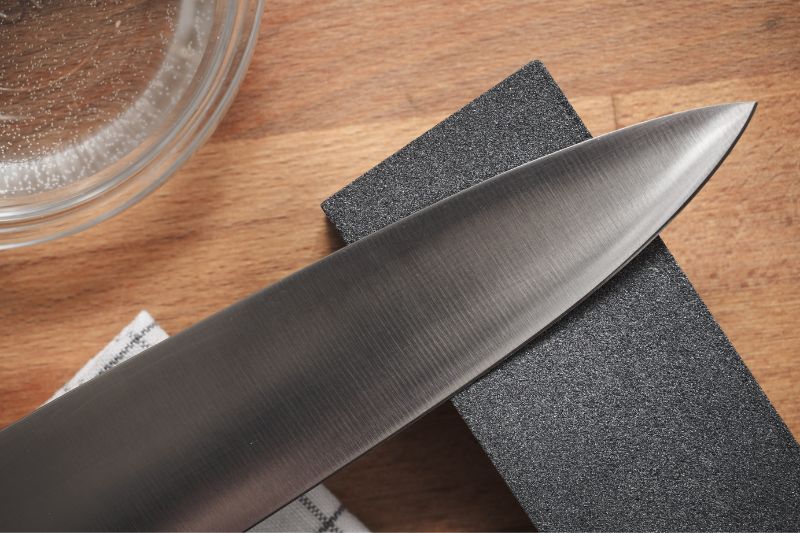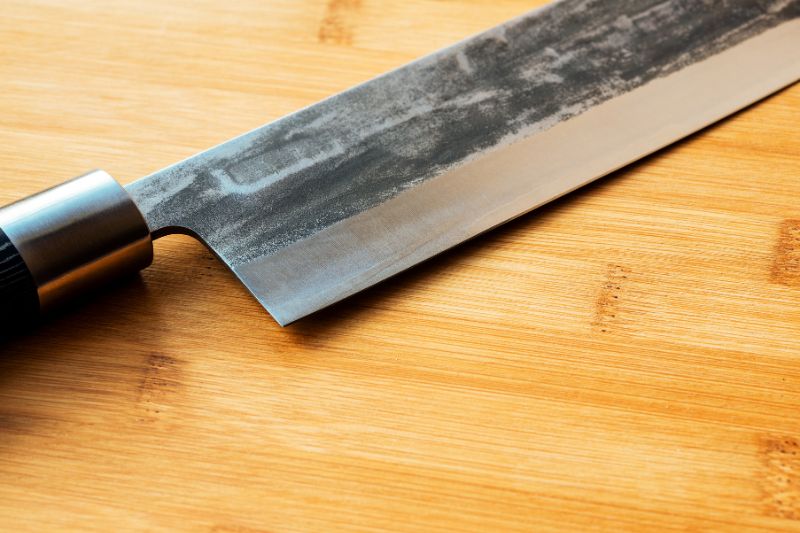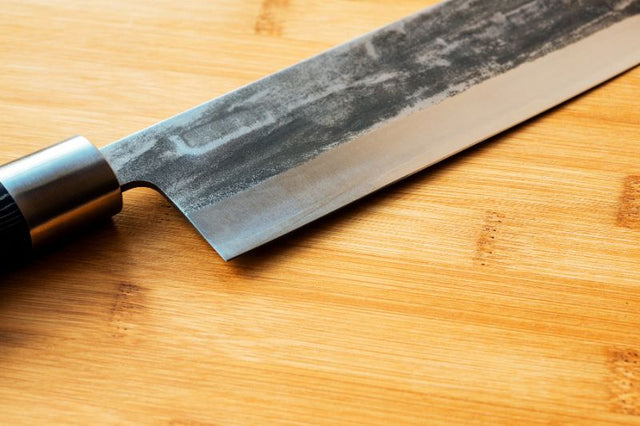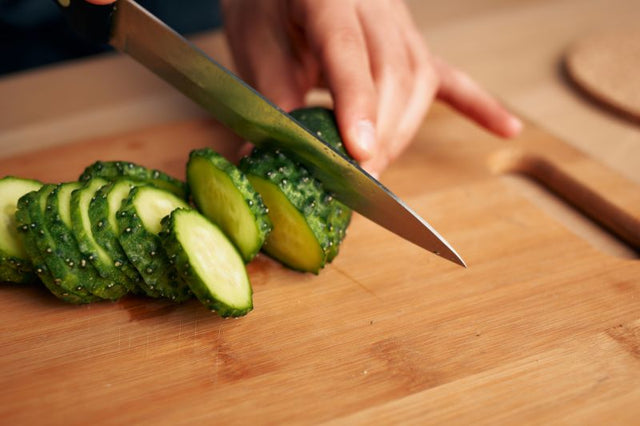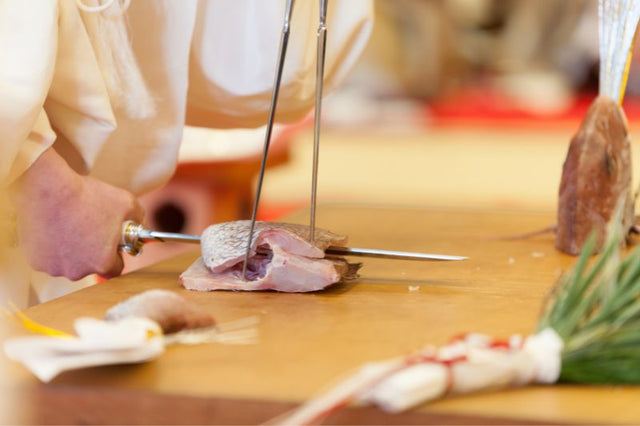What makes a knife a knife? There's more to it than just a blade and handle. Every surface, edge, and curve has a name and purpose. Understanding the thought put into the design of your most important kitchen tool will help you use it more effectively and also help you appreciate the elegance of its artisanship.
Knowing Your Knife
From tail to tip, I will take you through the different sections that make up a knife - both Japanese and Western styles. By the end of this article, you will better understand 'knife anatomy' and how certain parts can be used to your advantage when cooking. I guarantee you won't be able to look at a knife the same way again!
The Parts of a Japanese Knife
As promised, we'll begin from the end of the knife (that is to say, the bottom of the handle) and work our way to the point of the tip. Below is an illustration of two Japanese knives with Japanese-style wa handles. Further down is a Western-style knife that can be ignored for now but is there for comparison. Just note that a few of these features are only found on single-bevel Japanese knives, not double-bevel knives.

The Handle End (Ejiri)
You rarely touch this part of the knife, even when fully gripping the handle. It is, of course, a necessity of design that the handle has an end to it. Typically it is completely flat on a wa handle, and unless you're particularly creative, it shouldn't be used to do anything.
Handle (E)
The handle is part of the knife you physically interact with the most. It comes in many different shapes, but the most basic kind of wa handle shape is that of a smooth oval. The shape of the handle can dramatically change the comfort and cutting accuracy of a knife, but each person is different and may prefer a different style. Check out our article on magnolia wood handles if you want in-depth knowledge of different handle styles.
Tang (Nakago)
Nestled inside the handle is something called the nakago or, in English, a tang. All knives have these, but in Japanese knives, they are hidden. The tang is the lower piece of the blade that the handle is attached to. In this case, it is a half-tang (meaning it doesn't go to the bottom of the handle but only to about the middle).
Collar (Tsunomaki/Kakumaki/Kuchiwa)
We have an entire article dedicated to just this intricate piece of Japanese knife design. It has many names, but the correct one is tsunomaki. This polished piece of the handle protects the skin on the fingers from irritation during prolonged kitchen work. And as a bonus, it looks very nice! Ours are made from either buffalo horn or plastic.
Machi
Not every Japanese knife has a machi. It is a small gap between the neck of the knife and the handle. It's there so that the handle can be adjusted for size. For example, one could gently hammer the handle on the end to push it farther up the machi, bringing the handle closer to the blade. It's best to get a professional to do this for you. It's a neat feature, but you don't need to use it if the knife feels comfortable as it is.
Neck (Emoto)
The emoto provides a bit of distance between the handle and the actual cutting part of the blade. Your forefinger might sit comfortably in this area, depending on how you like to hold your knife. It makes the knife more maneuverable and gives some breathing space so that vegetables don't slide up the blade and hit your fingers as frequently.

Heel (Ago)
The ago, meaning 'chin,' is the flat piece of the blade that leads down to the point of the heel. Sometimes this piece of the blade is at a perfect 90-degree angle; other times, it may have a slight slant. In either case
Hamoto
Also a part of the heel, the hamoto refers to the heel from the point of the heel until about the mid-point of the blade. From the ago to the hamoto is where you should begin draw-cuts and do any rough chopping. It's also handy for fine cutting when the knife tip doesn't offer enough control.
Spine (Se/Mune)
The se or mune is the 'spine' that faces you as you use the knife. It is not necessarily used for anything; however, it can give you an indication of whether or not you're using a hand-made knife. Hand-made knives have spines that become slender as they draw nearer to the tip. This feature is an indication that it has been hammered into shape. A machine-made knife typically has one thickness all the way down the spine, as it is cut from a sheet of steel and sharpened.
‘Blade Road’ (Kireha)
Found only on single-bevel Japanese knives, a kireha or ‘blade road’ is used to describe the beveled side of the blade where it begins to slope down to the cutting edge. Learn more about single and double-bevel knives here.
Flat (Hira/Tsura)
Above the kireha lies the hira or tsura, which is the upper half of the beveled side of the blade. Rather than being angled, the hira is entirely flat. The combination of the two varied surfaces aids with preventing food from sticking to the side of the blade. It's also there for an aesthetically pleasing contrast.
Edge (Hasaki)
The total length of the cutting edge is called the hasaki. The hasaki includes from the point of the ago to the edge of the hamoto and all the way to the kissaki (the tip). Of course, this is where all the cutting happens!
Shinogi
Another term exclusive to Japanese knives. Shinogi is the line between the kireha and hira. It helps the blade to glide smoothly through food.
Belly/Curve(Sori)
The sori is simply the curve of the blade. However, unlike Western knives, not every Japanese knife has a sori. For example, the nakiri has a very nearly wholly straight edge. Knives that have a sori are perfect for rock-chopping and draw-cuts.
Tip/Point (Kissaki)
Finally, the tip of the blade, the kissaki. It is used for precision knife work - think slicing onions before you dice them, or trimming fat off meat. It is an essential part of a knife and also the most delicate part. Everyone is bound to accidentally chip the kissaki off a knife at some point! To avoid this, always keep your knife away from the edge of your kitchen bench, as this damage usually occurs when a knife is knocked onto the ground. Again, the nakiri is an exception, sometimes featuring a rounded tip.
Temper Line (Hamon)
One unique feature, mostly found on honyaki steel knives, is the hamon. It's a blurred 'misty' looking line where clay was used to separate the top piece of the blade from the cutting edge before quenching. This process makes the edge hard but leaves the spine softer to support the harder (but more brittle) cutting edge.
The Parts of a Western-Style Knife
Some parts of a Western knife are similar to that of Japanese knives. So, I won't bore you by going over the features that are the same. Instead, you'll find descriptions of a few significant differences below.

Butt
Some Western-style knives feature a metal extension from the end of the handle - or a rounded-off shape that ever-so-slightly hooks under the pinky finger when held. This piece is the butt of the knife. It is slightly more functional than the flat ejiri on Japanese handles, aiding with full-handed grips. Metal butts or handle caps are aesthetic pieces of decoration.
Rivets
Metal rivets are how the handle is secured to the blade's tang. In this case, it is a full tang that goes all the way to the butt of the knife, so two to three rivets are required. The rivets and extended tang give the knife a sturdy, heavy handle that balances the center of mass to the middle of the knife.
Bolster
The bolster is a smooth metal portion of the handle that leads to the blade. It increases comfort like a tsunomaki and indicates the knife's center of mass. It's another good indication that the knife has been forged and hammered rather than just cut from a metal sheet. The bolster can either run up the neck of the knife or partly continue a few millimeters up the heel of the blade, resulting in a rounded lower point.
Conclusion
That covers all the significant features of Japanese and Western knives - however, there's one aspect I didn't touch on in this article, and it has to do with knife bevels. But don't worry, I've got you covered; Head to our article about knife bevels for your next anatomy lesson!
Get Free Bonus Books
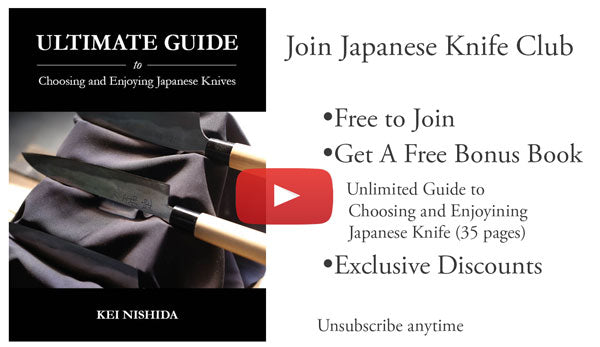
Sign up for free to the Japanese Knife Club to get advice and exclusive articles about how to choose Japanese Knives, and tips and tricks for using Japanese knives.
About the author
Kei Nishida
Author, CEO Dream of Japan
Certification: PMP, BS in Computer Science
Education: Western Washington University
Kei Nishida is a passionate advocate of Japanese craftsmanship, a writer, and the founder and CEO of Japanese Knife Co., Japanese Green Tea Co., and Japanese Coffee Co., all part of Dream of Japan.
His journey began with a mission to introduce the world to the exquisite flavors of Japanese green tea. Through Japanese Green Tea Co., he pioneered the import of premium tea grown in nutrient-rich sugarcane soil, earning multiple Global Tea Champion awards. He then expanded into the world of coffee, launching Japanese Coffee Co., the first company to bring Sumiyaki charcoal-roasted coffee to a global audience.
With a deep appreciation for Japanese artistry and tradition, Kei turned his attention to one of Japan’s most revered crafts: bladesmithing. Through Japanese Knife Co., he made handcrafted katana-style knives, created by a renowned katana maker, available outside Japan for the first time. These exceptional knives embody centuries of samurai sword-making expertise, blending tradition with modern functionality for chefs and collectors alike.
Kei’s journey continues as he uncovers and shares Japan’s hidden treasures—one sip, one blade, and one legacy at a time.


